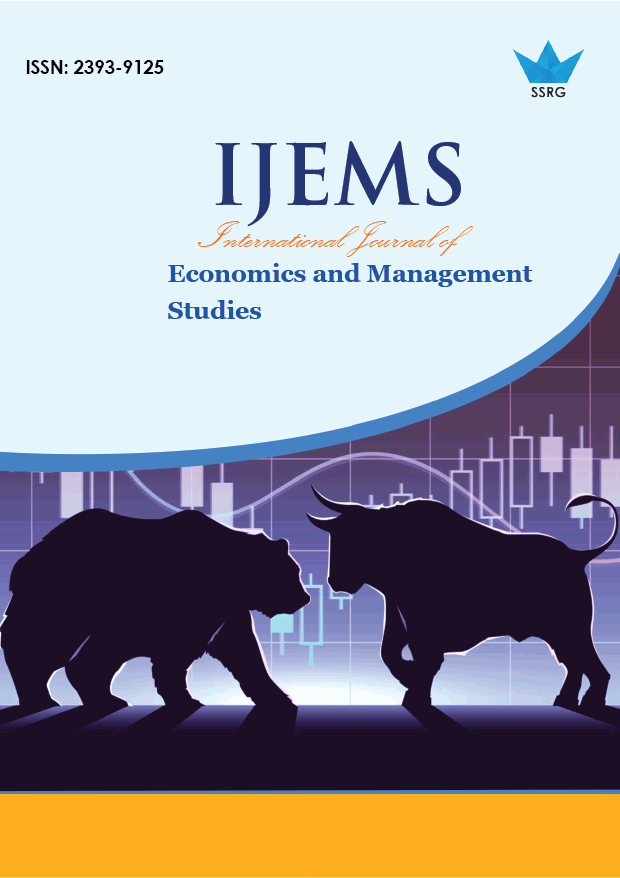Effect of Financial Incentives on Water Saving Behaviour amongst Teenagers in Ahmedabad

| International Journal of Economics and Management Studies |
| © 2025 by SSRG - IJEMS Journal |
| Volume 12 Issue 7 |
| Year of Publication : 2025 |
| Authors : Kaahan Agarwal |
How to Cite?
Kaahan Agarwal, "Effect of Financial Incentives on Water Saving Behaviour amongst Teenagers in Ahmedabad," SSRG International Journal of Economics and Management Studies, vol. 12, no. 7, pp. 18-24, 2025. Crossref, https://doi.org/10.14445/23939125/IJEMS-V12I7P103
Abstract:
Water conservation is preserving water and preventing its usage. Freshwater is a scarce resource, and roughly 4 billion people face water scarcity for at least a month every year. Even though water covers most of the Earth’s surface, only a small amount is freshwater that people can use for drinking, farming, and daily activities. As the population increases and cities grow bigger, the need for clean and safe water increases. Teenagers are the next generation to inherit the planet, and teens need to conserve freshwater. By saving water in simple ways, young people can help protect this valuable resource. It is also important for teenagers to spread awareness about water conservation. This paper presents an experiment where students were given rewards to complete and submit tasks related to water conservation to measure the effect of financial incentives on water-saving behavior in teenagers. The water-saving behaviour was measured using a Likert scale before and after the experiment. The results concluded that financial incentives increased water-saving behaviours in teens as measured by the General Attitude Towards Water Conservation (GAWC), Perceived Moral Obligation (PMO) and Behavioural Intentions (BI) subscales of the Likert scale.
Keywords:
Financial Incentives, Water saving behaviours, Teenagers, Ahmedabad, Water scarcity.
References:
[1] Water Scarcity, UNICEF, 2020. [Online]. Available: https://www.unicef.org/wash/water-scarcity
[2] Stephan Pfister et al., “Projected Water Consumption in Future Global Agriculture: Scenarios and Related Impacts,” Science of the Total Environment, vol. 409, no. 20, pp. 4206-4216, 2011.
[CrossRef] [Google Scholar] [Publisher Link]
[3] All-India Projected Water Demand in India by Different Uses (2010, 2025 and 2050), Central Statistical Office, Ministry of Statistics and Programme Implementation, Government of India, 2011. [Online]. Available: https://www.nabard.org/auth/writereaddata/tender/2010165456All_India_Projected_Water_Demand.pdf?utm_source=
[4] World Bank Group, How is India Addressing its Water Needs?, 2023. [Online]. Available: https://www.worldbank.org/en/country/india/brief/world-water-day-2022-how-india-is-addressing-its-water-needs
[5] Vishwa Mohan, Centre Asks Sugarcane Producing States to Consider Maharashtra Model of Promoting Drip Irrigation to Grow Water Guzzling Crop, The Times of India, 2018. [Online]. Available: https://timesofindia.indiatimes.com/india/centre-asks-sugarcane producing-states-to-consider-maharashtra-model-of-promoting-drip-irrigation-to-grow-water-guzzling-crop/articleshow/64248595.cms
[6] Kathryn Vasilaky et al., “What Works for Water Conservation? Evidence from a Field Experiment in India,” Journal of Environmental Economics and Management, vol. 119, pp. 1-20, 2023.
[CrossRef] [Google Scholar] [Publisher Link]
[7] Gujarat Samachar, Impending Water Crisis: Ahmedabad Utilises 152% Groundwater, 2024. [Online]. Available: https://english.gujaratsamachar.com/news/gujarat/impending-water-crisis-ahmedabad-utilises-152-groundwater
[8] Jay Raval, Venkat Ram Reddy Minampati, and Shreya Dave, “Sustainable Water Management Practices and Citizen Participation in Ahmedabad, Gujarat, India,” International Journal of Environmental Sciences, vol. 9, no. 2, pp. 53-62, 2023.
[Google Scholar] [Publisher Link]
[9] Parth Shastri, Smart Meters, Smarter Choices: How Societies Slashed Water Wastage, The Times of India, 2025. [Online]. Available: https://timesofindia.indiatimes.com/city/ahmedabad/smart-meters-smarter-choices-how-societies-slashed-water wastage/articleshow/119353227.cms
[10] Giacomo Giannoccaro et al., “Design of an Incentive-Based Tool for Effective Water Saving Policy in Agriculture,” Agricultural Water Management, vol. 272, 2022.
[CrossRef] [Google Scholar] [Publisher Link]
[11] Emma L. Giles et al., “Acceptability of Financial Incentives for Health Behaviours: A Discrete Choice Experiment,” PLoS ONE, vol. 11, no. 6, pp. 1-19, 2016.
[CrossRef] [Google Scholar] [Publisher Link]
[12] R. Archana Reddy et al., “Development of a New Measure to Check Attitude towards Water Conservation,” MethodsX, vol. 10, pp. 1-9, 2023.
[CrossRef] [Google Scholar] [Publisher Link]
[13] Yurina Otaki, Yutaro Onuki, and Yuga Hosokawa, “Influence of Financial Incentive and Nudge, Alone and Combined, On Water Saving Behaviors,” Sustainable Futures, vol. 7, pp. 1-9, 2024.
[CrossRef] [Google Scholar] [Publisher Link]
[14] How Farmers in India Can Be Incentivised to Save Water, International Growth Centre, 2024. [Online]. Available: https://www.theigc.org/blogs/climate-priorities-developing-countries/how-farmers-india-can-be-incentivised-save-water
[15] The Abdul Latif Jameel Poverty Action Lab (J-PAL), The Abdul Latif Jameel Poverty Action Lab, 2017. [Online]. Available: https://www.povertyactionlab.org/evaluation/creating-incentives-decrease-water-waste-zambia
[16] Chris Edwards, Behavioural Economics Shows Smart Incentives Work for Water - Inside Water, Inside Water, 2025. [Online]. Available: https://insidewater.com.au/behavioural-economics-shows-smart-incentives-work-for-water/
[17] Corey L. Lott, The Effect of Financial and Social Incentives on Water Conservation, 2017.
[Google Scholar] [Publisher Link]

 10.14445/23939125/IJEMS-V12I7P103
10.14445/23939125/IJEMS-V12I7P103